 |
| TO THE DEVIL...A DAUGHTER (1976), which I watched for the first time today, was the last horror film produced by Great Britain's legendary Hammer Films Studios. It's unlike any other Hammer film ever made. Gone is the Gothic glamour, period sets and costumes, the back lot villages and reused interiors. Instead, we get a film shot on actual locations in Germany and England. And there's no franchise hero or villain on display here. Just pure evil. Richard Widmark stars as John Verney, an expert on the occult and the author of several bestselling books on the subject. Verney is tasked by Henry Beddows (Denholm Elliott) to protect his young daughter, Catherine (Nastassja Kinski), a nun newly arrived in London from a convent in Germany. It seems that a band of Satanists, led by defrocked priest Father Michael Rayner (Christopher Lee), need the young woman in order to complete a blasphemous ritual in which Catherine will be possessed by the spirit of the demon Astaroth. Verney and Rayner square off in a duel to the death for the life and soul of Catherine. TO THE DEVIL...A DAUGHTER was based on a novel by British horror writer Dennis Wheatley. Three writers, Chris Wicking, John Peacock and Gerald Vaughan-Hughes, adapted the material for the screen and Peter Sykes does an admirable job directing. The story is told in what appear to be disconnected fragments of story lines during the first thirty minutes of running time but everything eventually ties together fairly nicely. However, there are a few loose ends (which the screenwriters acknowledge) and the ending is abrupt, confusing and unsatisfying (a point that all of those involved in the production admit). Still, the film is handsomely mounted with a nice cast. I'll watch almost any film with Christopher Lee in it (except for the Tolkien butt-numbers, thank you very much) and Richard Widmark lends an air of old fashioned Hollywood leading man to the proceedings. In fact, the German co-producers of the film insisted on an American "name" actor to help sell the film in both the U.S. and Europe. Denholm Elliott is good, Honor Blackman, more than a decade removed from her turn as Pussy Galore in GOLDFINGER is still attractive here and newcomer Nastassja Kinski holds her own among the veteran players. And she's not shy about full frontal nudity either. By the time TO THE DEVIL..A DAUGHTER was made, Hammer Films was on its' last legs. The studio didn't have enough funds to produce the film on its' own and had to rely on a German production company to help finance the project. Following in the wake of ROSEMARY'S BABY (1968) THE EXORCIST (1973) and, to some extent, IT'S ALIVE (1974), TO THE DEVIL...A DAUGHTER was an attempt to make an earnest, straightforward horror film about a young woman, demonic possession and a devil baby as key plot elements. The film became the biggest box office hit in Hammer history but that financial success proved too little, too late. Most of the profits from the film had to be paid to the Germans who had put up the money for the movie and Hammer Studios was left with a mostly bare cupboard. TO THE DEVIL...A DAUGHTER was the last Hammer film for many years until the recent revitalization of the studio and brand. Even with a clunky ending, TO THE DEVIL...A DAUGHTER works as a first-rate horror film and if you're a fan of the genre, you really need to see this film. Recommended. |
Tuesday, January 28, 2014
TO THE DEVIL...A DAUGHTER
Monday, January 27, 2014
THE MILDLY INTERESTING CAPTAIN NEMO
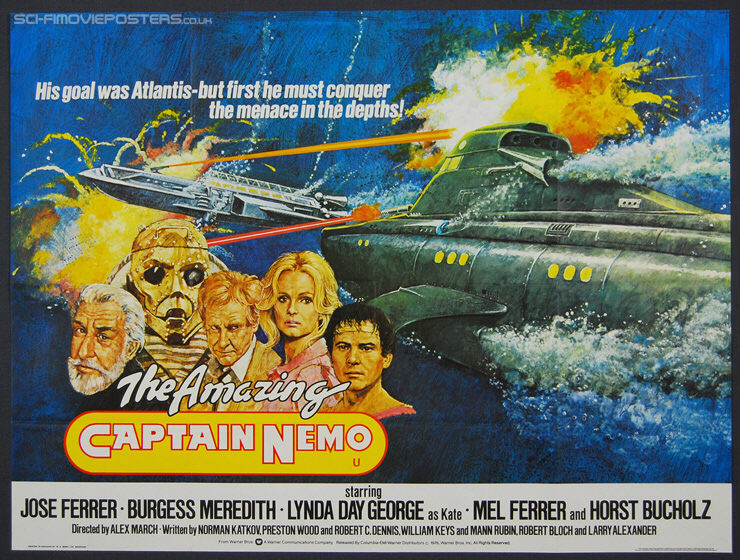 |
| The only amazing thing about THE AMAZING CAPTAIN NEMO (1978) is the fact that it took seven (count 'em, seven!) writers, including the illustrious Robert (PSYCHO) Bloch to come up with the screenplay for this swill. THE AMAZING CAPTAIN NEMO was originally broadcast on CBS television in 1978 as a three-part mini-series entitled THE RETURN OF CAPTAIN NEMO. The three episodes were intended to serve as a pilot for a proposed weekly television series, a series which never got picked up by the network. The material was produced by Irwin Allen (although his name does not appear in the onscreen credits). Allen had scored ratings gold in the 1960s with his popular sf television shows VOYAGE TO THE BOTTOM OF THE SEA, LOST IN SPACE, THE TIME TUNNEL and LAND OF THE GIANTS. By 1978, Allen had become known as the "master of disaster" producing blockbuster disaster films THE POSEIDON ADVENTURE (1972) and THE TOWERING INFERNO (1974).You've gotta wonder why he would want to return to episodic, network television when his films, cheesy as they were, were making money. I suspect one motivation was the desire to catch a ride on the runaway trainload of science fiction films and television shows that sprang up in the wake of George Lucas's game changing STAR WARS (1977). You can see the STAR WARS influence in NEMO. One submarine passageway is clearly inspired by a similar hallway in the Death Star and all of the hand guns fire blaster rays instead of bullets. The three episodes of RETURN OF CAPTAIN NEMO were bundled together and padded out for a 102 minute running time and theatrically released overseas as THE AMAZING CAPTAIN NEMO (a clear attempt to try and squeeze some financial gain out of the property). That's a British quad poster at the top of this post and I dearly wish that what was on the screen was anywhere near as good as what's depicted on that poster. Unfortunately, it's not. In the film, Captain Nemo (Jose Ferrer) is found in suspended animation aboard his legendary submarine The Nautilus (redesigned here to look more like a whale or dolphin). The captain is revived and soon pressed into service against the mad Professor Cunningham (Burgess Meredith) who threatens the world from his own underwater vessel, The Raven. In the first episode, Nemo prevents Cunningham from destroying Washington D.C., in the middle segment, Nemo must put an end to leaking containers of radioactive material at the bottom of a deep sea trench, while in the finale, Nemo discovers the lost continent of Atlantis but has to stop Cunningham from using Atlantean technology to rule the world. Ferrer is without a doubt the best thing about the whole enterprise. He plays Nemo with an air of understated flamboyance. It would have been nice to have seen him really cut loose and go over the top to play Nemo with an air of smug superiority and arrogant condescension. Burgess Meredith phones in his performance as Cunningham (a lame name for a villain if there ever was one). Meredith was far more fun to watch as The Penguin on the BATMAN television series. The supporting cast is comprised of Tom Hallick and Burr DeBenning (who?) as intrepid U.S. Navy intelligence officers who join Nemo's crew, Warren (FORBIDDEN PLANET) Stevens as their boss, Mel Ferrer as a double-crossing nuclear scientist, the lovely Lynda Day George (what would a 1970s television show be without her?) as his assistant and Horst Buchholz as, believe it or not, King Tibor of Atlantis. Buchholz's sole claim to fame is as an answer to a much asked trivia question (who played the Magnificent Seven?). The control room sets of both the Nautilus and Raven have a similar design and I suspect that they are one and the same with all of the Nautilus scenes shot first, the set re-dressed, and then used as the Raven (or vice versa). The special effects range from passable to bad but the designs of both subs are impressive, even if they're never really clearly shown due to the "underwater" effects. THE AMAZING CAPTAIN NEMO suffers from non-existent character development, wooden acting by most of the cast, a cliched screenplay and iffy special effects. Perhaps I shouldn't be too hard on this one because it was made-for-television with a limited budget and production schedule. But a bad movie is still a bad movie regardless of circumstances and THE AMAZING CAPTAIN NEMO certainly falls into that category. |
Sunday, January 26, 2014
DIE! DIE! MY DARLING!
 |
| I watched DIE! DIE! MY DARLING! (1965) the other night. I'd recorded it off of TCM. I'd seen this one before but it was years ago. Here are a few of the thoughts I had while watching the film. The title is extremely similar to another horror film released in 1965, DIE MONSTER, DIE! starring Nick Adams and Boris Karloff. The storyline of DDMD is reminiscent of yet another film released in 1965, William Wyler's THE COLLECTOR starring Terence Stamp and Samantha Eggar. DDMD also prefigures Brian De Palma's CARRIE (1976) in depicting a crazed, religiously fanatic older woman who is determined to do harm to a young woman. Oh and DDMD steals an entire sequence from Hitchcock's PSYCHO (1960). Wildly swinging overhead light fixture in a cellar anyone? DIE! DIE! MY DARLING! stars Tallulah Bankhead (in her last film appearance) and the beautiful Stephanie Powers. It's a psychological horror film produced by the legendary Hammer Films in Great Britain (under the title FANATIC) and released in the U.S. by Columbia. The film is part of the 1960s cycle of "horror hag" films in which older actresses (Bette Davis, Joan Crawford, Joan Fontaine, Olivia de Havilland and Bankhead) all had their fading careers briefly rejuvenated by appearing in low-budget horror films. DIE! DIE! MY DARLING! finds Powers visiting Bankhead to pay her respects to the old woman. It seems Powers was engaged to Bankhead's late son before he met his death in an automobile accident. Powers intends to briefly visit the woman in her isolated country home and then return to London and her current fiance. Bankhead will have none of that. Believing that Powers is her daughter-in-law and a fallen woman, Bankhead imprisons Powers in an attempt to "save" her stained soul. There are some twists and turns with dark secrets revealed before Powers is finally rescued and Bankhead dead. Director Silvio Narizzano does a workmanlike job filming Richard Matheson's screenplay. Narizzano would go on to a bit more fame in 1966 by directing the smash hit GEORGY GIRL. DIE! DIE! MY DARLING! is a good little horror film. It's nothing spectacular but worth seeing at least once if you're a genre fan. |
Friday, January 17, 2014
BROADWAY DANNY ROSE
 |
| I saw BROADWAY DANNY ROSE (1984) when it was first released, back in the days when I never missed a Woody Allen film. I hadn't seen it since until I watched it again this afternoon. It's a minor Allen film but a very good one and I found myself laughing aloud several times while watching it. Allen plays Danny Rose, a talent manager who handles the lamest of the lame acts. His clients include a blind zyxlophone player, a one-legged tap dancer, a one-armed juggler, a husband and wife balloon folding act, a lady who plays drinking glasses, a bird act, you get the picture. His main client is Lou Canova (Nick Apollo Forte), a washed up lounge singer who is desperately trying to mount a comeback with Danny's help. Lou has a gig at the Waldorf Astoria. Milton Berle will be there and there's a chance for Lou to get a spot on Berle's television special and open for him at Caesar's Palace in Vegas. The afternoon of the performance, Lou asks Danny to pick up Tina (Mia Farrow), Lou's mistress, and bring her to the show. Tina is the widow of a mob enforcer and the object of affection of a minor mobster. Through a case of mistaken identity, the hoods think Danny is Tina's lover and a wild chase ensues with Danny and Tina pursued by two would-be hit men. Danny and Tina have a hilarious adventure and finally end up at the show. Lou does well but he's decided to dump Danny at Tina's insistence and go with another manager. Danny is devastated, his career practically ruined. He spends Thanksgiving at his apartment serving frozen turkey dinners to his other clients. But an unexpected knock on the door changes things. Shot in gorgeous black and white by Gordon Willis BROADWAY DANNY ROSE features various locations in New York City and New Jersey as the setting for the film. Allen's narrative conceit is to have the story told by a bunch of real-life comics who are sitting around a table and eating at the Carnegie Deli. The comics include Sandy Baron, Corbett Monica, Jackie Gayle, Morty Gunty, Will Jordan, Howard Storm and Jack Rollins. Full of one-liners, slapstick humor and heart, BROADWAY DANNY ROSE is a winner. Recommended. |
Thursday, January 16, 2014
WHIPLASH 3
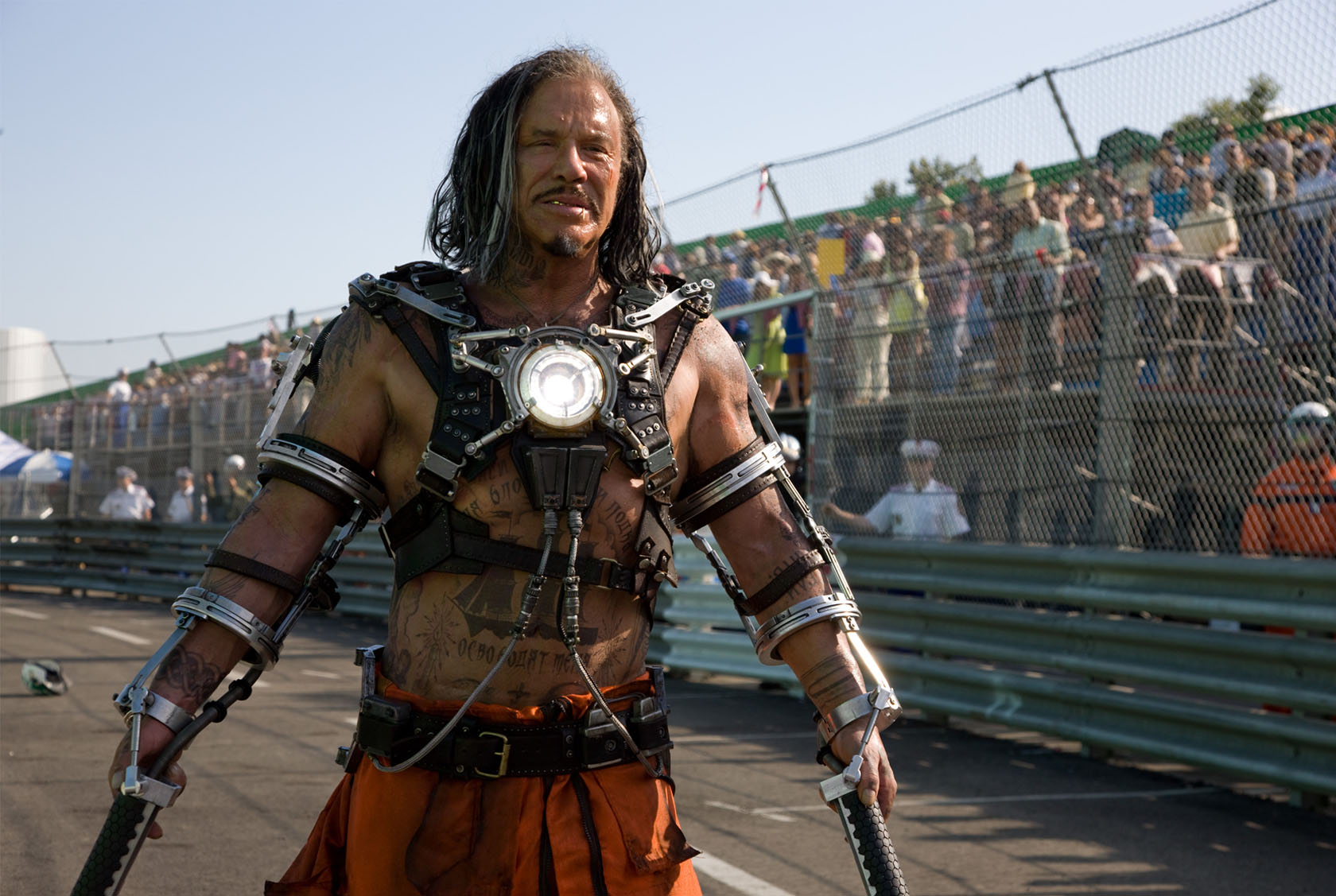 |
| Raise your hand if you ever thought you'd live to see the day when Mickey Rourke would play a Marvel Comics super villain in a major motion picture. |
WHIPLASH 2
 |
| I watched WHIPLASH (1948) the other day, thanks to a recent broadcast on TCM which I recorded. This is another minor film noir produced by Warner Brothers in the late '40s. Dane Clark stars as Mike Gordon, a painter in California. He's struggling to improve his art when one of his paintings on display at a local bar is purchased by a mysterious woman. Mike is determined to meet this woman and give her her money back because he doesn't think his work is good enough. He meets Laurie Durant (the lovely Alexis Smith), who refuses his refund and tells him she really likes the painting. Mike falls head over heels for Laurie who warns him that she's not right for him. Doesn't matter to Mike. Then one day, Laurie leaves without saying goodbye. The only clue to her whereabouts is the painting, wrapped for mailing to a New York City address. Mike travels to New York, finds the address but the occupant of the building, a Dr. Vincent, is never at home. Mike rents a studio apartment in which to paint and becomes friends with his neighbor Chris Sherwood (Eve Arden as every body's gal pal, a role she excelled at playing). One night Mike and Chris and her Texas oilman suitor go to a nightclub where, lo and behold, the lounge singer is none other than the missing Laurie. Mike goes backstage to see her and she once again begs him to leave. Mike won't go and he gets roughed up by some musclemen but he gives as good as he gets which causes him to be noticed by the owner of the club, Rex Durant (Austin's own Zachary Scott). Of course, Rex and Laurie are married but in addition to running the nightclub, the crippled Durant also manages boxers and he thinks Mike has what it takes to be a champ. Mike reluctantly throws in with Durant. Since he's a painter and a boxer, Mike's ring name becomes Michael Angelo (get it?). The more fights Mike has, the more brutal and violent he becomes. Meanwhile, that mysterious Dr. Vincent that the painting was addressed to ? Turns out he's the doctor for Durant's fighters. He's also Laurie's brother and a hopeless alcoholic who is drowning his guilt in booze The cause of the guilt is the fact that Vincent operated on Durant after a near fatal car crash, an operation that while it saved Durant's life, left him crippled for life. With this heady mix of forbidden love, a crooked fight game and a bottle full of guilt, things naturally come to an explosive climax in which both Dr. Vincent and Durant meet their demise. Mike returns to California to paint and Laurie finds him there at the end of the film. WHIPLASH isn't a bad movie at all. The leads are good and they do their best under the direction of Lewis Seiler. The script by Harriet Frank, Jr. and Maurice Geraghty is solid if unspectacular. WHIPLASH is a better than average B movie and a very minor film noir. In fact, I'm not so sure that I would classify it as a total noir due to the happy ending. Noir or not, WHIPLASH is worth seeing at least once, especially if you're a fan of the genre. |
Wednesday, January 15, 2014
BACKFIRE
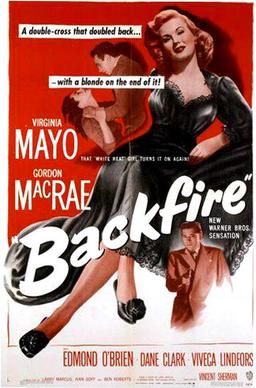 |
| I watched BACKFIRE (1950) for the first time the other night, thanks to a recent broadcast on TCM. The film is a minor film noir with an interesting pedigree. The film, which was written by Ivan Goff, Larry Marcus and Ben Roberts and directed by Vincent Sherman, was made in 1948 and promptly shelved by Warner Brothers Studio. In the meantime, screenwriters Goff and Roberts penned the script for WHITE HEAT (1949), which, in addition to the legendary James Cagney, featured Edmond O'Brien and Virginia Mayo, both of whom had appeared in the still unreleased BACKFIRE. In addition, O'Brien starred in the film noir classic D.O.A. in 1950. Warner Brothers, taking notice of the box office and critical successes of those two films, decided to release BACKFIRE in 1950 and strike while the irons of Goff, Roberts, O'Brien and Mayo were hot. BACKFIRE stars Gordon MacRae as Bob Corey, a wounded WWII vet who is about to be released from the veteran's hospital at the beginning of the film. He plans to open a ranch with his buddy Steve Connolly (Edmond O'Brien) but the doctors say Corey, even after he recovers from his wounds, won't be able to do any heavy physical activity. Corey is nursed back to health by Julie Benson (Mayo) and one night a mysterious woman (Viveca Lindfors) appears in his room to tell him that Steve is in trouble and needs Bob's help. Was she real or just a drug induced hallucination? When Bob is released from the hospital, he sets out to find his missing buddy only to be brought in police Captain Garcia (Ed Begley), who believes the missing Steve may be involved in a murder case. Bob disobeys Garcia and sets out on his own in a desperate attempt to find Steve. Bob meets several characters who provide him with much needed information (all in the form of extended flashback sequences) and some of these people meet their death after telling Bob what they know (no, Bob doesn't kill them, the real killer does). Bob finally finds Steve, who has been injured in an attempt on his life. The real killer is revealed, a shootout ensues and Bob, Steve and Julie ride off into the sunset to open the ranch of their dreams. BACKFIRE has a cast of minor actors, none of whom ever achieved major stardom. Edmond O'Brien, Virginia Mayo, Gordon MacRae, Dane Clark, Viveca Lindfors and Ed Begley, never became big name stars but they all did have film careers that had the occasional starring roles and many supporting ones. BACKFIRE isn't a bad little film but it's far from a great noir (due mainly to the happy ending). Worth seeing once if you're a fan of the genre. |
Sunday, January 12, 2014
IF IT AIN'T BROKE...
 |
| Having been born in 1956, I came along too late to experience the Golden Age of Pulps (the 1930s and 1940s). But, being a child of the '60s, I did get to enjoy the First Age of Pulp Reprints. I've read dozens of Doc Savage novels, several Shadow adventures and a few Spider adventures. Heck, I've even got an original SPIDER pulp magazine in my collection. I'm far from an expert on pulp fiction but I do know my way around the field to a fair degree. I've read enough of this material to know what I like and what I don't like. What I don't like are attempts to modernize classic pulp characters and bring them into the "present day", whenever it is that said "present day" is taking place. For me, characters like Doc, the Shadow and The Spider, are products of their specific places and times. They belong to the era in which they were originally created and conceived, the roaring heart of the crucible of 1930s pulp fiction. Dynamite Comics recently launched a revival/updating of The Spider and I just finished reading Volume One, TERROR OF THE ZOMBIE QUEEN. In the story, written by David Liss and illustrated by Colton Worley, The Spider operates in a version of modern day New York City that isn't really our New York City (there are zeppelins in the skies above the city in the first panel on the first page but these magnificent airships never appear again throughout the subsequent six issues collected here in this trade paperback). The Spider is still Richard Wentworth and he still wages a war against crime but there are several major changes to the character. To begin with the most obvious, his costume is a redo of what was seen in the 1938 serial, THE SPIDER, produced by Columbia Pictures. This is an okay costume but it's the movie Spider, not the pulp Spider. In the pulps, Wentworth donned a fright wig, fangs and a cloak and dispensed bloody justice with two .45 caliber automatics. The pulp Spider became a monster to fight monstrous foes. In this new version, he's just a guy in a webbed mask and cape. He's not The Spider that I've come to know and love. Wentworth's best friend and trusted aide, Ram Singh, knows that Wentworth is The Spider. That much is still the same in the new series but here Singh is an attorney and the slightly racist undertones of "master and foreign manservant" have been done away with. An improvement in the characters and their relationship? Perhaps but only slightly. Nita Van Sloan also knows Wentworth's secret and Nita and Richard are still in love in this new iteration. The trouble is, Nita is now married to Police Commissioner Stanley Kirkpatrick, who is also a very good friend of Wentworth's who also suspects he may be The Spider. This is a major change in the dynamics of these three characters. In the new version, Wentworth is a former U.S, soldier who fought in Iraq and Afghanistan and uses his military experience and knowledge to aid the NYPD on criminal cases that are beyond the ordinary. This gives Wentworth access to crime scenes and police labs. Oh, and there's a crooked cop, Joe Hilt, who is determined to prove that Wentworth and The Spider are one and the same, come hell or high water. TERROR OF THE ZOMBIE QUEEN isn't the new Spider's first adventure. We're told that he's previously battled The Cholera King, The Silver Falcon and The Terror and His Legions (among others). In this new adventure, he's up against a woman and her muscleman aide who dress as ancient Egyptian gods in order to turn New York citizens into flesh-eating zombies through the use of a chemical weapon manufactured by the company owned by Wentworth's father. Much of the action in the book occurs at night and in the rain making the pages very dark. More than once I had to look very hard and long at the art to determine what I was seeing and I wasn't always successful in doing so. Artist Colton Worley is a competent enough penciller but in many of his layouts and page designs, he eschews hard, distinct panel borders, which makes the art "bleed" from one scene to the next. This makes for some confusing pages in which it's hard to determine the sequence in which word balloons and captions should be read and even just what exactly it is that we're looking at. I understand that it's now 2014 and the vast majority of comic book readers most likely don't want to read a series set in the 1930s. That's ancient history to them. Updating, modernizing and changing The Spider for today's audience makes sense from a commercial stand point and I can understand why this series was done this way. But I don't have to like it and I sure as hell don't. Here's the real Spider.  It just doesn't get any better than this. |
Thursday, January 9, 2014
BELL, BOOK AND CANDLE
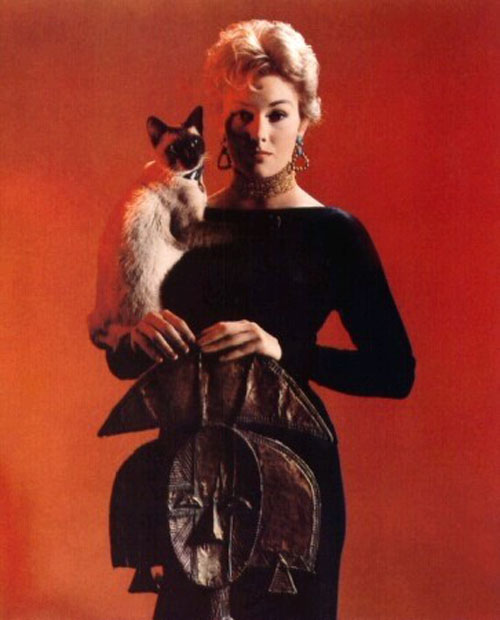 |
| Judy and I and our friend Jeffrey watched BELL, BOOK AND CANDLE (1958) the other day. Thanks to Jeffrey for bringing with him his DVD of the film. I recall seeing this film one night on a local television station back in the 1960s. It wasn't a network television broadcast, just a local station running the film to fill a two-hour time slot. I enjoyed it then and I enjoyed it the other day. Based on a successful Broadway play, first produced in 1950, the film version stars James Stewart and Kim Novak. Stewart is a New York City book publisher who comes under a spell cast by his downstairs neighbor (and witch) Novak. Novak is part of a coven of witches including Elsa Lanchester and Hermione Gingold while her brother, Jack Lemmon, is a warlock in training. Comedian Ernie Kovacs is a besotted author determined to write a book about real witches in New York but even with the help of Lemmon in the writing of the book, publisher Stewart rejects the manuscript as preposterous. Romantic complications ensue before everything is ironed out in the final reel. BELL, BOOK AND CANDLE is a handsomely mounted production. The leads are all solid (was Novak ever lovelier?) but Stewart struck me as bit old for her. Stewart and Novak had previously worked together that same year on Alfred Hitchcock's masterpiece (and his greatest film) VERTIGO and it's interesting to watch them together in a very different film. BELL, BOOK AND CANDLE received two Academy Award nominations: Best Art Direction and Best Costume Design. It's not a great film by any stretch of the imagination but it was a sheer delight to watch. Recommended. |
Monday, January 6, 2014
AVENGERS 1959
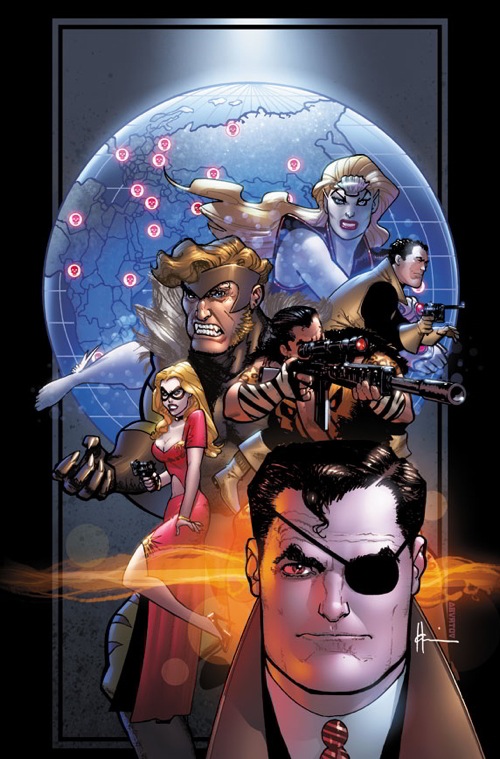 |
| I read AVENGERS 1959 yesterday. This Marvel Comics trade paperback reprints issues #1-5 of the AVENGERS 1959 mini-series. The script and art are both by the great Howard Chaykin, who is one of my all-time favorite comic book creators. I love almost everything about this book. I love Chaykin's art. I love the concept. An Avengers team comprised of characters that were alive and well and operating in the Marvel Universe in 1959 are assembled. The team is made up of Nick Fury, the Blonde Phantom, Kraven the Hunter, Sabretooth, Dominic Fortune and Namora. Added to the mix is Powell McTeague, a British dandy with occult powers who is clearly modeled on the John Steed character played by Patrick Macnee on the classic British TV spy series THE AVENGERS. The Avengers face off against various Nazi supermen and superwomen who survived WWII. The super Nazis are being manipulated by forces within the U.S. intelligence agency (at least, I think that's what's going on). The head manipulator, one Geoffrey Sydenham is apparently an acolyte of the dread Dormammu but that demonic entity is sadly, only name dropped here (pity, as I kept expecting him to eventually show up and I'd love to see Chaykin's take on him). Oh, and did I mention that such familiar Marvel Universe locales as Wakanda, Latveria and Madripoor serve as the settings for some of the action in the book? Plus, there's nifty cameos by former Howler Eric Koenig and 1950s Agent of A.T.L.A.S. Gorilla Man. Yep, there's a lot to like here but there's also much to dislike. For starters, event though I love Chaykin's artwork, there's one two page sequence that makes absolutely no sense to me whatsoever (both visually and narratively) and I even read it twice trying to figure it out. The plot takes practically forever to be adequately explained and even then I'm still not quite sure just what all of this hugger mugger was really all about. The main villain, Sydenham, is not punished for his crimes (although his super Nazi henchmen and henchwomen are) and the book ends on a decidedly ambiguous note. I'm really torn on this one. Thumbs up for the Chaykin art (or at least 99% of it). Thumbs up on the characters and the concept. Thumbs down on a plot and storyline that could have benefited greatly from a really good editor (of which, there seems to be none in today's comic book business). Bottom line: I really wanted to like this one and I did, to some extent, just not as much as I was expecting to. |
Saturday, January 4, 2014
THE LOVED ONE
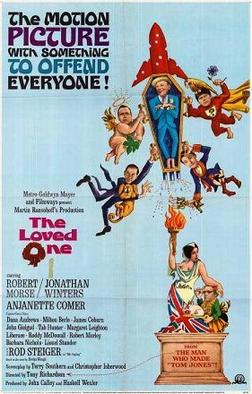 |
| British director Tony Richardson won a Best Director Academy Award for TOM JONES (1963), which also was that year's Best Picture of the Year Oscar winner. TOM JONES beat out AMERICA, AMERICA, CLEOPATRA, HOW THE WEST WAS WON and LILIES OF THE FIELD. In my estimation, the film that should have been awarded Best Picture of the Year for 1963 was HUD. I've seen TOM JONES and I think it's one of the worst films to win a Best Picture of the Year Academy Award in the last fifty years. Nevertheless, coming off of the commercial and critical success of TOM JONES, Tony Richardson was riding high and film buffs were anxious to see what he'd do for an encore. What Richardson did was THE LOVED ONE (1965) a jet black comedy (based on the novel by Evelyn Waugh with a screenplay by Terry Southern and Christopher Isherwood) about the American funeral industry (the film also takes aim at Hollywood, organized religion, consumer culture and other targets). The film was advertised as "The Motion Picture With Something To Offend Everyone!" and by 1965 standards, that's a pretty accurate assessment. I watched this cult classic last night for the first time (thanks to a recent showing on TCM) and I'm here to report that I wasn't offended in the least by anything in the film. Your mileage may vary. I also didn't think it was anywhere near as funny as I was led to believe it would be. Oh, I chuckled a few times (it's hard not to laugh at a film in which the great Jonathan Winters plays two parts) but I didn't think it was hilarious. Odd, yes. Bizarre, certainly. Ahead of its' time, definitely. With black and white cinematography by Haskell Wexler and editing by Hal Ashby (both men would later forge their own careers as film directors) THE LOVED ONE has a cinema verite vibe comprised of hand held camera shots and on-location shooting. It certainly doesn't look like the standard mid-'60s Hollywood studio produced comedy and is closer in spirit, visual style and tone to Stanley Kubrick's masterpiece DR. STRANGELOVE. The film finds a young Brit, Dennis Barlow (Robert Morse, who is win, place and show in the Dave Barry lookalike contest) coming to America for the first time. He takes up residence in Los Angeles with his uncle, Sir Francis Hinsley (John Gielgud) who works at a movie studio. When a film project under development gets canned, Sir Francis suddenly finds himself out of work after thirty years at the studio. He takes his own life and it's up to young Dennis to make the funeral arrangements. When Dennis visits the enormous Whispering Glades cemetery and mortuary, he literally goes down the rabbit hole. The facility is run by the Reverend Wilbur Glenworthy (Winters) a con man and real estate tycoon par excellence masquerading as a spiritual leader. Dennis meets a beautiful but simple minded young cosmetician, Aimee (Anjanette Comer), along with the truly outre mortician Mr. Joyboy (Rod Steiger in perhaps the film's funniest performance), and a casket salesman played by Liberace. Dennis is smitten with Aimee and woos her with plagiarized poetry. Aimee is far too stupid to realize that the words he showers her with are not his own. Mr. Joyboy has a twisted fixation on Aimee, which makes for one of the more unusual love triangles in film history. The trouble is, Whispering Glades has reached it's limit as far as available land for burials goes. Rev. Glenworthy devises a scheme to turn his property into a retirement community but in order to do so, he must first disinter the existing graves. How to do so without causing a massive scandal? Enter his brother Henry (also played by Winters), who runs a pet cemetery owned by the reverend. Henry once worked at the movie studio but he was cut lose along with the late Uncle Francis earlier in the film. Dennis works for Henry and the two come up with a sure fire plan, courtesy of Gunther, a young rocket scientist played by Paul Williams. The plan is to launch the coffins into low earth orbit and the first rocket is scheduled to blast off with the remains of a NASA astronaut on board. But someone else is in that coffin when the rocket is launched. THE LOVED ONE was a box-office disaster when it was first released but it went on to be recognized as a cult classic. I've known about the film for years but never had the opportunity to see it until last night. To be honest, I'm not quite sure what to make of it. I didn't hate it. It was imminently watchable and totally unpredictable. As I said, I did get a few laughs out of it but I didn't think it was a comedy masterpiece by any stretch. Bottom line, THE LOVED ONE is certainly worth seeing at least once if you're a hardcore film fan. |
Thursday, January 2, 2014
MY FAMOUS MONSTERS 59
 |
| The titular character from William Castle's film MR. SARDONICUS adorns the cover of FAMOUS MONSTERS #126. Nice painting by Basil Gogos. In addition to MR. SARDONICUS, this issue features articles on KING KONG, Bela Lugosi and Renfield. |
Wednesday, January 1, 2014
MY FAMOUS MONSTERS 58
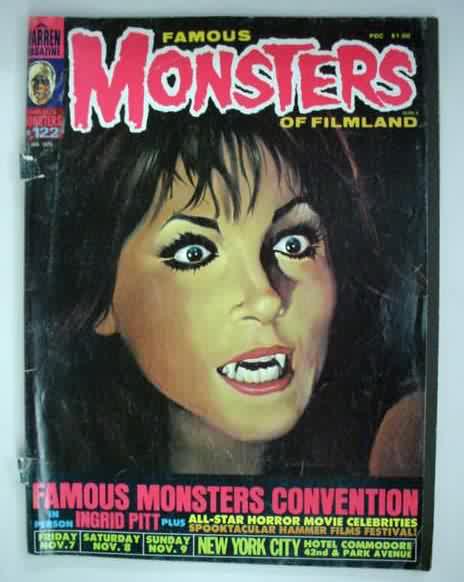 |
| The lovely, vampiric Ingrid Pitt is featured on the cover of FAMOUS MONSTERS #122, a cover which is nothing less than a blatant advertisement for the Famous Monsters Convention in New York City. |
Subscribe to:
Posts (Atom)